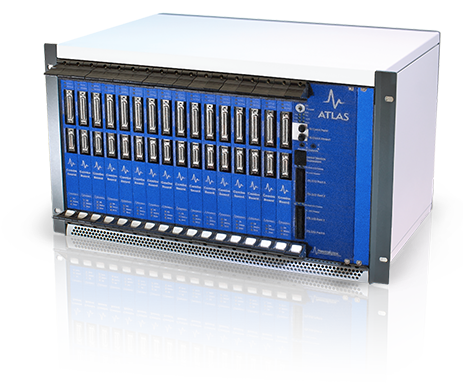
ATLAS Acquisition Amplifier
Full Bandwidth, High Definition Signals from 512 Macro and Microelectrodes
Features
High Definition: 40 kHz sampling frequency per channel
High Density: 512 Channels
High Fidelity: 24 bit, 19 bits linear, A/D converters
- Simultaneous sampling on all 512 channels
- Full bandwidth recording: DC to 8 kHz
- Flexible, software-controlled reference selection
- Records multi-scale signals of widely differing impedances
- Wide dynamic input range prevents artifact and signal clipping. No need for gain adjustment: +/- 132 mV AC, +/- 1 V DC
- Record through external stimulation without input range adjustment or input disconnections
- DC capability provides zero-settling time post stimulation
- High common-mode rejection for artifact suppression
Catalog Number
31-0605-0139
The “workhorse” of the ATLAS Neurophysiology System, the ATLAS Acquisition Amplifier is capable of recording multi-scale signals of differing amplitudes at high sampling rates. Extensive channel referencing options enhance human microwire recording results. The foundation of the ATLAS Acquisition Amplifier is the ATLAS Combo Board, performing both analog-to-digital signal conversion and digitally controlled reference selection.
Dual research and clinical recording streams of macro and microwire signals may be acquired with different sampling rates and filter settings. All channels are available for each stream through the Pegasus software.
The ATLAS Acquisition Amplifier contains the most flexible channel reference selection capabilities with up to 8 references selectable for each 32 channel bank and 7 signals globally shared across the system. This allows each microwire bundle to be referenced to a close macro or quiet microwire electrode. All reference selections are software-controlled, eliminating the need to change reference connections inside the patient headwrap. References can also be changed “on the fly” to optimize microwire recordings.
The DC response (+/-1 V) allows accurate recording during and after stimulus delivery – with zero recovery time needed even when inputs are saturated. This allows investigation of EEG after discharge signals. Very slow, long-term DC electrode potential shifts may also be recorded. The large DC input range avoids saturation for various electrode types.
Sub-microvolt resolution over the large +/-132 mV AC input range provides optimal signal resolution even in the presence of large artifacts without clipping.
| Specifications: | Benefits: | |
| Channels | 512 | Increased Coverage |
| Analog to Digital | 24 bit | Sub-microvolt Resolution |
| Precision/Accuracy | 19 bits linear | Very Low Distortion |
| AC Input Range | -132 mV to 132 mV | Record the Entire Signal |
| DC Input Range | -1 V to 1V | Pre-Ictal Shifts Recorded |
| Common-mode Rejection | 110 dB Input Board direct 90 dB with DRS Programmable Reference | Clean Signals |
| Sample Rate Maximum | 40 kHz | Better Analysis of HFO’s |
| Noise Level | 1.3 µV rms | Signal to Noise Increased |
| System Configuration | • Stand-alone Operations • Operations with Clinical EEG • NetCom Operation |
System Flexibility |
